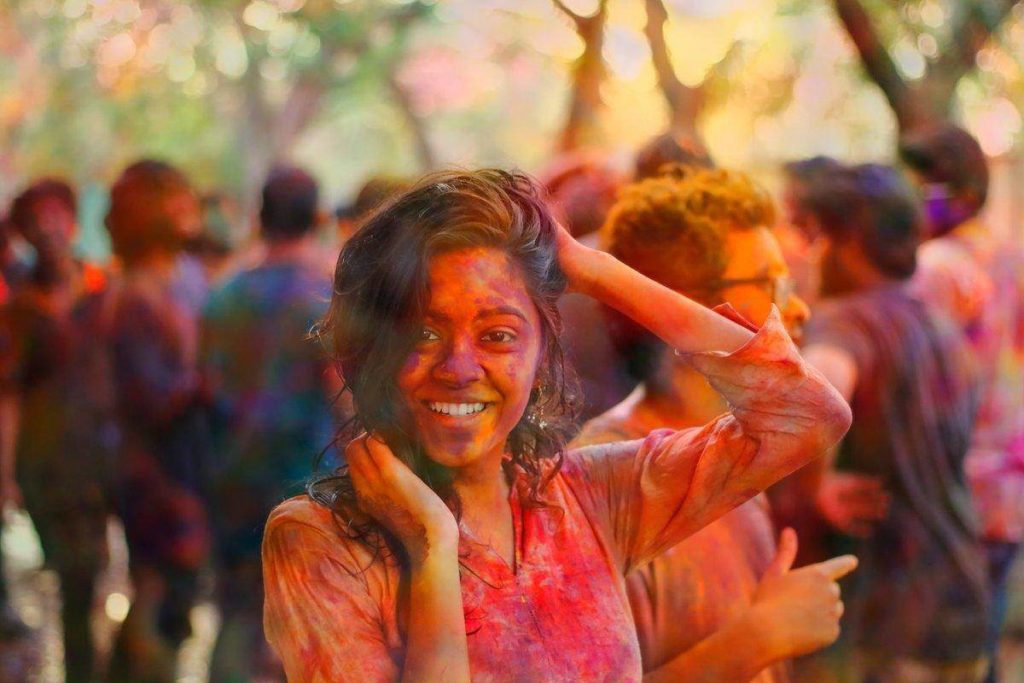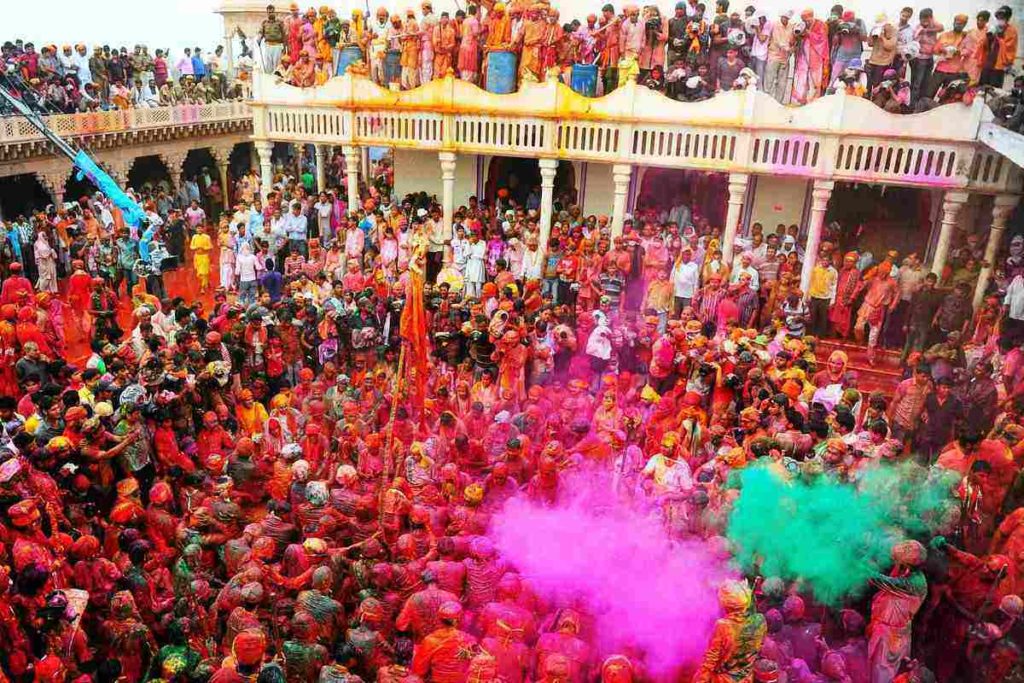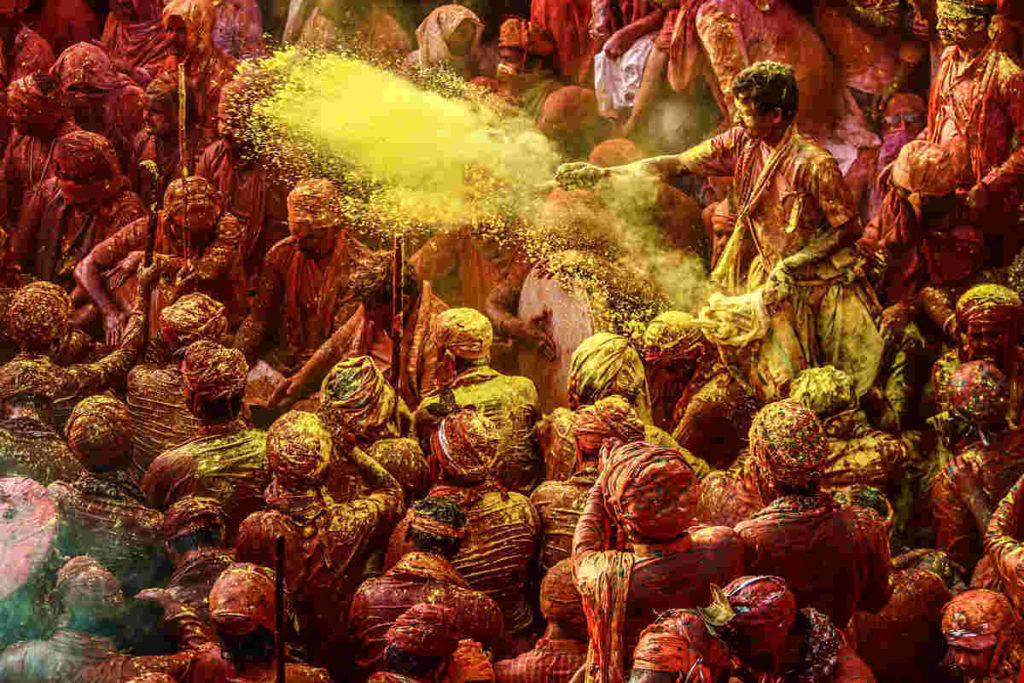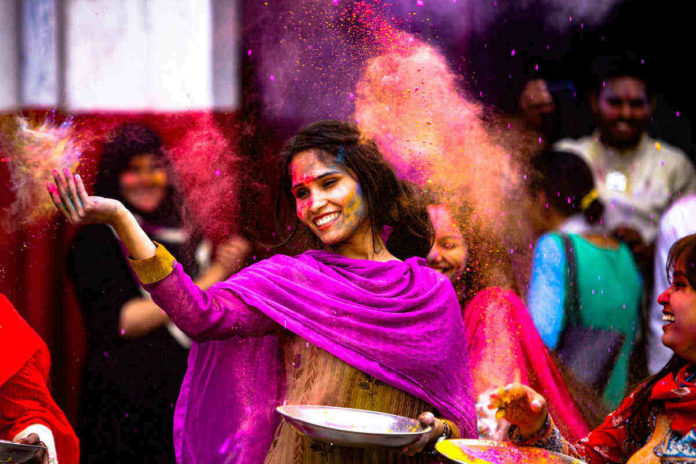A first timer’s guide to how to make the most of Holi celebrations in India
Every year, Holi, also known as the ‘Festival of Colours’, is celebrated on the day after the full moon in the month of March in India. Marking the end of winter and the beginning of spring season in North India, Holi is a Hindu festival that is celebrated all over the country. It symbolises the victory of good over evil and is considered a time to come together and spread love within the community. In many parts of India, Holi is also a way of saying thanks to the Gods for a good harvest.
The streets are painted in vibrant colours as merrymakers toss a kaleidoscope of Holi powders or gulaal into the air, coating each other in a magical, iridescent glow as Holi songs play in the background. The mood is lively and upbeat, and the energy is undeniably contagious. Experiencing Holi in India is a must for everyone who loves to explore different cultures and wants to immerse in a festival that allows you to let go, forget all conflicts and celebrate life with colours and love.
Whether you’re planning to visit India and experience Holi firsthand or are simply interested in learning more about the festival, this article will tell you everything you need to know.

Why is Holi celebrated?
Holi celebration mentions date back to as early as the 4th century in ancient Sanskrit texts. However, the exact origin date of the festival is unknown. According to the Hindu mythology, Holi commemorates the burning and destruction of a demoness named ‘Holika’ with the help of Hindu God of preservation- Lord Vishnu, hence, marking the victory of good over evil and the name ‘Holi’.
Another Holi story is associated with Lord Krishna. The folklore suggests that Holi got its name as the ‘Festival of Colors’ from the childhood antics of Krishna and his blue skin – a result of a she-demon poisoning him. Young Krishna was worried that his love interest Radha won’t like the colour of his skin and so his mother playfully encouraged him to smear her with paint as well so they would be the same. Till date, their relationship is honoured by people applying colour to each other- friends, families and even strangers as a Hindi saying goes ‘Holi hai bura na mano’ (On Holi, we are all family).
Why Munnar in India is one of the most romantic destinations in the world
How is Holi celebrated?
Holi is a two-day festival that begins with bonfires where people gather together on streets, in colonies and city centres to watch the burning of Holika effigies. This commemorates the triumph of goodness and also symbolises the end of conflicts among friends, families and communities.
The following day the fun part of Holi begins. From flavoursome traditional Indian dishes to colourful dance parties and fun riots of gulaal (Holi powder) on streets and upbeat Holi songs- every single aspect of this festival is sheer fun. An array of scrumptious dishes like dahi bade, katahal ki sabzi, poori, kachori and delectable sweets, including gujia, pua and malpua are traditionally prepared in all households during Holi. One typical Holi delicacy that you must try is thandai– a creamy, delicately spiced milk drink. Some people prefer just thandai while some have it along with bhaang- an edible form of cannabis.
During the first half of the day, people use water-filled balloons, sprinklers and water guns to smear each other with wet paint or rang. By noon, everyone goes back to their homes to wash off the wet paint and prepare for the evening celebrations when people visit each other with dry Holi colours and exchange gifts and greetings.
Best places in India to celebrate Holi
When planning your Holi holiday, it can get a little overwhelming to decide the best places to celebrate Holi in India. Here is a list of some of the most popular Holi destinations in India:
Relive the playful and platonic flirtations of Radha and Krishna in Mathura Holi celebrations
Visit Mathura for a traditional Holi experience!
If you are looking to experience the Holi festival in its most traditional manner, Mathura is the ideal place for you. Located in the state of Uttar Pradesh in North India, Mathura is the birthplace of Krishna and one of the seven venerated Holi cities for Hindus. Approximately 145 kilometres away from the capital city Delhi, Mathura is accessible via road and rail.

When in Mathura, you can explore Vrindavan and Barsana to enjoy Holi at its best. Vrindavan or Brindaban, is a historic city located in the Brij Bhoomi region, around 11 kilometres away from Mathura city, where Lord Krishna is believed to have spent most of his childhood. Holi celebrations in Vrindavan begin almost a week in advance as Phoolon wali Holi (Holi celebration with flowers) precedes the Festival of Colour here. On the day of the main festival, the best spots to watch and immerse in the colourful spectacles is the Dwarkadheesh Temple.
In Barsana, the birthplace of Radha, Holi is celebrated in the most unique manner over a period of five to seven days. Known as Lathmar Holi in Barsana, on the first day of Holi celebrations men from neighbouring villages come to Barsana to playfully chase and the local women like a game of hide and seek. On the second day, women choose to show their displeasure with the aid of laths or sticks; the entire ordeal depicting the antics of young Krishna who had to be fended off by Radha and gopis (her cohorts) in a similar fashion. The folklore might get lost in translation and come across as violent but it is actually a playful tradition carried out in jest, and an interesting way to spend your holi holiday.
Add a philanthropic colour to your Holi vacation and explore the slums of Mumbai
Plan a trip to Mumbai for a Holi Holiday of giving back to those in need
If you want a unique Holi experience, explore the iconic paradox of the city of Mumbai where the privileged and the poor live side by side as skyscrapers stand next to some of the world’s biggest slums. Mumbai is home to India’s second-busiest international airport- the Chhatrapati Shivaji International Airport and well connected to most countries all over Asia and the world.
The land of dreams and the home of Bollywood- India’s thriving film industry, Mumbai offers a variety of Holi celebrations. You can enjoy rain dance parties, street celebration and live performances with delectable street food and bhaang or you can choose to celebrate Holi with the underprivileged.

The iconic locality of Mumbai, Dharavi is Asia’s largest and one of the world’s largest slums with an area of over 2.1 square kilometres and a population of more than 700,000. Many guided tours that provide snacks and natural colours are organised for celebrating Holi in Dharavi. These tours typically last for four-five hours giving you a unique opportunity to meet with the residents of these slums and celebrate Holi with them. The best part is that most tour agencies contribute most of their earnings to the benefit of these communities.
Revel in India’s rich folklore with Holi celebrations in Purulia in West Bengal
Holi colours, Chhau- martial arts, acrobatics and more in Purulia!
For yet another unique Holi celebration, the rural district of Purulia is a perfect getaway. Located in the state of West Bengal, Purulia is well connected and accessible via road and railways. The nearest airport is the Birsa Munda Airport, which is approximately 100 km away from the city. Celebrated with folk music and dance, in addition to the vibrant Holi colours, over a period of three days, Holi here has a distinct Bengali influence. Immerse in some of India’s oldest folk traditions like the tribal chhau dance, which is a unique blend of martial arts and acrobatics and folk Bengali music during your Holi holiday in India at Purulia.
When in West Bengal for Holi, you cannot miss out on traditional Bengali delicacies like rasgulla (sweet) and maach bhaat (rice and Bengali fish curry).
Safety and travel hacks for spending a Holi holiday in India
With all the fun and revelry, sometimes things might get a little out of hand and it is always good to be prepared for the best and the worst when travelling.
Here are a few things to keep in mind when planning your trip to India for Holi celebrations:
- Do not carry or wear valuables like expensive watches or jewellery. They might get stained with paint or worse stolen.
- Wear comfortable old clothes so you can enjoy the festival of colours without worrying about your attire.
- Avoid unsupervised public areas. Instead go for guided tours or gatherings organised by temples or travel agencies with proper arrangements and security in place.
- Do not eat a lot. Eat small amounts because the number of dishes will generally be a lot and every Holi dish is rich and might make you feel stuffy if you ever eat.
- Protect your hair with a scarf and wear sunglasses to protect your eyes.
- Wear closed shoes as the streets to protect your feet.
- Cover your camera or phone with plastic zip bags.
- Insider’s tip: Apply a lot of moisturizer or olive oil to your face and body. It makes washing off the colour easier later on.
When is Holi?
- Holi 2020 dates: 9th and 10th March
- Holi 2021 dates: 28th and 29th March


Excellent description of Holi.
Mesmerized and visualised the complete celebration. Worth reading.Keep on sharing such articles. God bless u.👍